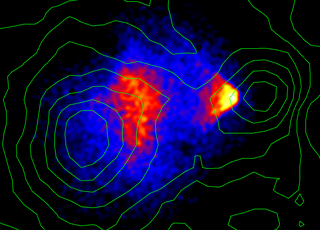October 5, 2007 feature
Another piece in the dark matter puzzle

Most scientists agree that most of the matter in the universe is dark. Dark matter, which is undetectable through direct observation, can only be inferred because of its effects on the matter that we can see.
“In principle,” Signe Riemer-Sørensen, a scientist at the Dark Cosmology Centre at the University of Copenhagen, tells PhysOrg.com, “dark matter can’t be seen directly. We know it has to be some kind of particle that we have not seen on earth, and that it can exist without being detected here.”
Riemer-Sørensen is one of many scientists around the world interested in studying dark matter. Because it is so prevalent, physicists agree that understanding how dark matter works is an important fundamental question that could lead to a better knowledge of the universe, and the basic laws upon which it operates. Riemer-Sørensen and her group, which also consists of scientists from the University of Patras and the Aristotle University of Thessoaloniki in Greece, and the University of Oslo, are working on a way to pin down some of the characteristics of dark matter.
“We took one specific theory about dark matter,” Riemer-Sørensen explains. “We look at a specific type of decaying particles, and if they represent dark matter, they will decay and transform into photons in x-rays.” The particles in question are axions, hypothetical elementary particles used in theories describing “extra” dimensions. The idea, she says, is to look for an area of the universe that has a great deal of dark matter, and then look for weak x-ray emissions.
Riemer-Sørensen and her peers looked at colliding clusters of galaxies. “A good place to do this is clusters of galaxies because they are very heavy and consist of approximately 85 percent of dark matter. The stars and galaxies are only about five percent, and then there is about 10 percent hot gas, which does also emit x-ray.”
She points out that the galaxies within clusters of galaxies do not collide in the classical sense. Rather, they pass through each other. “The only thing colliding is the gases in the galaxy cluster.” During the galactic collision, the gases are displaced due to friction.
“You compare this to the gravitational potential from dark matter,” Riemer-Sørensen continues. “Because the two galaxy clusters have collided, and the gas has been displaced. In a normal cluster of galaxies, the galaxies, the gas, and the dark matter are all contained within the same region. In the colliding case there is a clear separation, and to find the putative x-ray emission from axions, we look in regions where there is a lot of mass, but very little gas.”
So, did Riemer-Sørensen and her colleagues find the weak dark matter x-ray emissions? “We didn’t find any clear signs of x-ray emissions from axions in these regions,” she says. “And that tells us something about dark matter.” If dark matter particles do follow the reactions of decay set forth in the theory of axions as dark matter, then dark matter has an extraordinarily long lifetime. “If dark matter does decay,” Riemer-Sørensen insists, “then the lifetime of the axions is at least three million billion years, which is twenty thousand times longer than the lifetime of the universe.”
“This is a piece of information that tells us something about how dark matter must behave,” Riemer-Sørensen continues. “So for technical reasons x-rays can currently be eliminated as a way to detect it.”
She hasn’t stopped trying to detect dark matter more directly, however. “Now we’re working on going into gamma rays to see if there’s a signature there.”
Dark matter may have stumped scientists for three decades, but little by little the puzzle is starting to fit together.
Copyright 2007 PhysOrg.com.
All rights reserved. This material may not be published, broadcast, rewritten or redistributed in whole or part without the express written permission of PhysOrg.com.





















